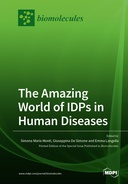Explore

The Amazing World of IDPs in Human Diseases
0 Ungluers have
Faved this Work
Login to Fave
It is now clearly established that some proteins or protein regions are devoid of any stable secondary and/or tertiary structure under physiological conditions, but still possess fundamental biological functions. These intrinsically disordered proteins (IDPs) or regions (IDRs) have peculiar features due to their plasticity such as the capacity to bind their biological targets with high specificity and low affinity, and the possibility of interaction with numerous partners. A correlation between intrinsic disorder and various human diseases such as cancer, diabetes, amyloidoses and neurodegenerative diseases is now evident, highlighting the great importance of the topic. In this volume, we have collected recent high-quality research about IDPs and human diseases. We have selected nine papers which deal with a wide range of topics, from neurodegenerative disease to cancer, from IDR-mediated interactions to bioinformatics tools, all related to IDP peculiar features. Recent advances in the IDPs/IDRs issue are here presented, contributing to the progress of knowledge of the intrinsic disorder field in human disease.
This book is included in DOAB.
Why read this book? Have your say.
You must be logged in to comment.
Rights Information
Are you the author or publisher of this work? If so, you can claim it as yours by registering as an Unglue.it rights holder.Downloads
This work has been downloaded 113 times via unglue.it ebook links.
- 113 - pdf (CC BY) at Unglue.it.
Keywords
- Actin
- alpha-Synuclein
- Biology, Life Sciences
- Cancer
- circular dichroism
- cytoskeleton remodeling
- de novo
- EPR spectroscopy
- evolutionary origin
- flexibility
- fluorescence
- gene duplications
- Human Disease
- importin
- interface core and rim
- intrinsically disordered protein
- intrinsically disordered protein (IDP)
- intrinsically disordered proteins
- intrinsically disordered regions
- isothermal titration calorimetry
- isothermal titration calorimetry (ITC)
- linear motifs
- Mathematics & science
- Methyl-CpG-binding protein 2 (MeCP2)
- molecular docking
- molecular recognition features
- n/a
- NADH-26S proteasome
- Neurodegenerative Diseases
- NMR
- nuclear magnetic resonance (NMR)
- nuclear protein 1 (NPR1)
- peptide
- pre-structured motifs (PreSMos)
- proline-rich motif
- protein degradation
- protein misfolding
- protein stability
- protein structural dynamics
- protein-DNA interaction
- protein-ligand interaction
- protein–protein interactions
- proteostasis
- Reference, information & interdisciplinary subjects
- Research & information: general
- Rett Syndrome
- secondary structure propensity
- SH3 domain
- single nucleotide variants
- site-directed spin labeling
- ubiquitin independent degradation
- ubiquitin-proteasome system
- WASp interacting protein
Links
DOI: 10.3390/books978-3-0365-1029-3Editions

